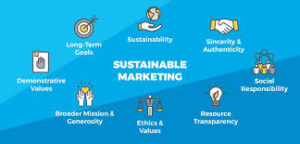Explore Sustainable Marketing strategies for 2025, including circular economy initiatives, AI-driven personalization, and transparent storytelling. Learn how brands can build trust and engage eco-conscious consumers.

Sustainable Marketing
In 2025, sustainable marketing has evolved from a niche strategy to a mainstream imperative. Brands are not only expected to deliver quality products but also to demonstrate environmental stewardship, ethical practices, and social responsibility. This shift is driven by a more informed and conscientious consumer base, increased regulatory pressures, and a global push towards sustainability.
🌿 Core Principles of Sustainable Marketing
1. Transparency and Authenticity
Consumers demand honesty about sourcing, production processes, and environmental impact. Brands are increasingly adopting blockchain technology and QR codes to provide traceable product journeys, ensuring that sustainability claims are verifiable and not mere marketing tactics .
2. Circular Economy Practices
The traditional “take-make-dispose” model is being replaced by a circular approach. Companies are designing products for longevity, repairability, and recyclability. Initiatives like take-back programs and product refurbishing not only reduce waste but also foster consumer loyalty .
3. Ethical Sourcing and Fair Trade
Highlighting locally sourced or fair-trade products builds trust and supports community growth. Sharing the story behind products connects customers emotionally, reinforcing the brand’s commitment to ethical practices .
4. Green Packaging
The use of biodegradable and recyclable packaging is becoming standard practice. Brands are investing in innovative packaging solutions that minimize waste and appeal to eco-conscious buyers .
📈 Emerging Trends in Sustainable Marketing
1. Carbon Footprint Measurement Across All Channels
Brands are assessing the emissions linked to their marketing efforts, from traditional media buys to digital campaigns. Platforms like Scope3 are enabling companies to track and reduce their carbon output, making sustainability a key performance indicator .
2. Digital Over Print
The shift from print to digital marketing reduces paper waste and energy consumption. Digital campaigns offer broader reach and engagement, aligning with sustainability goals while enhancing marketing effectiveness .
3. Collaborations with Eco-Conscious Influencers
Partnering with influencers who advocate for sustainability can amplify a brand’s message. These collaborations help brands resonate with eco-conscious audiences and convey a genuine commitment to environmental responsibility .
4. Localized Sustainable Marketing Campaigns
Addressing local environmental issues makes sustainability efforts more relatable. Brands are tailoring campaigns to resonate with regional concerns, fostering a deeper connection with their audience .
🛠️ Implementing Sustainable Marketing Strategies
-
Conduct Sustainability Audits: Regularly assess your supply chain, production processes, and marketing channels to identify areas for improvement.
-
Set Clear Sustainability Goals: Define measurable objectives, such as reducing carbon emissions or increasing the use of recycled materials.
-
Engage Stakeholders: Collaborate with suppliers, customers, and community organizations to promote sustainable practices.
-
Communicate Transparently: Share your sustainability journey through reports, social media, and product labeling to build trust with consumers.
🌟 Conclusion
Sustainable marketing in 2025 is not just about promoting eco-friendly products; it’s about embedding sustainability into the core of business operations. Brands that authentically commit to environmental and social responsibility will not only contribute to a greener planet but also build lasting relationships with their customers.


